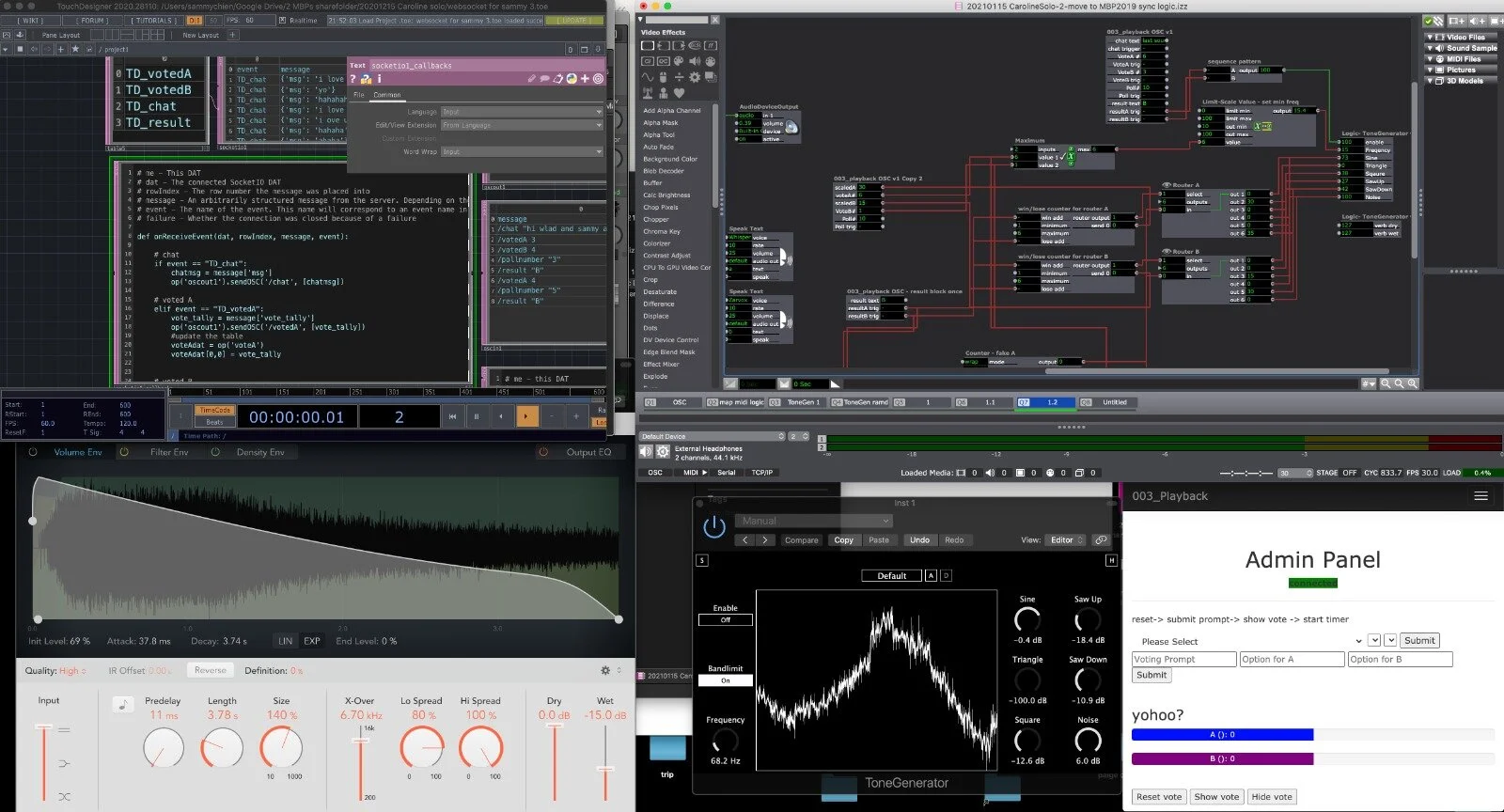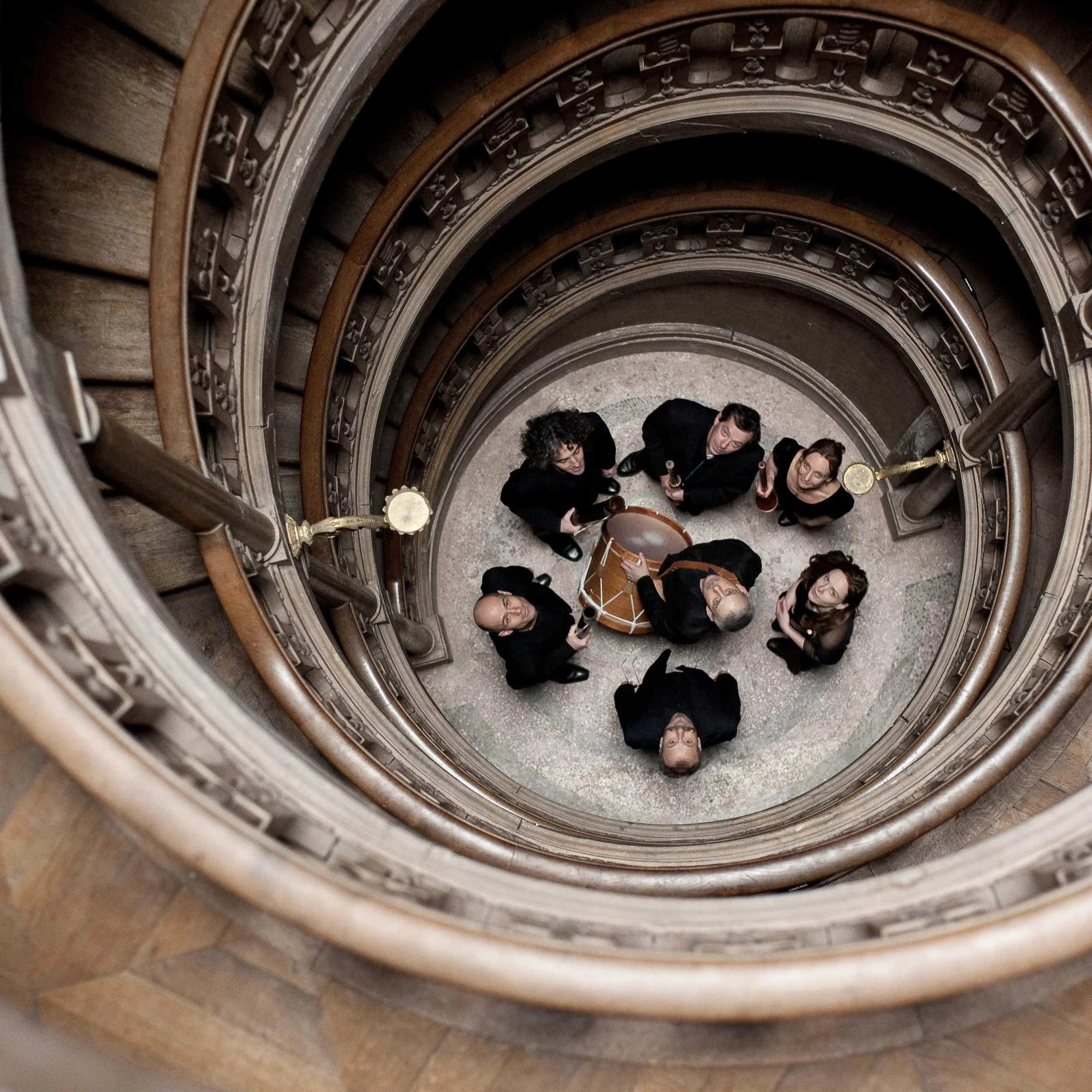Stir Q&A: Caroline MacCaull gets digitally interactive with 003_playback at the Dance Centre
Majority rules as audience votes on the direction the artist takes in January 20 show
003_playback. Photo by Megan Morrison
AS A RECENT Simon Fraser University graduate, dancer Caroline MacCaull has found herself neck-deep in the world of new media and performance art. Her latest work, 003_playback, investigates the collaborative potential between technology and dance—a subject that she often finds at the forefront of her research.
Produced by the Dance Centre as a part of its Digital Dance Series, 003_playback explores the manipulation of movement through computer programming and audience intervention. MacCaull gives her viewers a unique task: as she relinquishes complete control of her work, she asks her audience to vote on the lighting, soundscape, and movement. The 15-minute piece— which is actually only a short one-minute movement phrase—is then manipulated and repeated as MacCaull answers for her viewer’s requests.
Though this is one of her first works since obtaining her Bachelor’s in Fine Arts, she is no stranger to the digital dance sphere.
As an SFU student, she was first introduced to dance technology during an internship with interdisciplinary media artists Chimerik Collective. This opportunity allowed MacCaull to work directly under Chimerik’s co-founder and artistic director Sammy Chien, who is regarded as a master in the graphic programming system called Isadora. Now a full-time member and collaborator, MacCaull credits much of her growth as an emerging artist in her field to Chien’s mentorship.
While also at SFU, she worked closely with professors Stefan Smulovitz, Rob Kitsos, and Wladimiro Woyno to cultivate her own choreographic method, which she has since termed as “edit to choreograph”. In this approach, MacCaull uses computer programming to edit and manipulate recorded movement, which is then randomized and played back to her to build choreographic phrases.
003_playback is presented free via livestream on January 20 at 6 pm, with registration required. Audience members with all levels of experience and interests are welcomed.
Stir had the opportunity to chat with MacCaull about her upcoming work, as well as her thoughts surrounding the creation of performance art in the COVID-19 digital era.
What do you think 003_playback would look like if it was created outside of the pandemic context— a year ago or a year in the future?
“Even though it started with research I was doing before, it was really birthed during COVID because I wanted to make something that’s more engaging for the audience. As an audience member for all these new works, I realized that the passive experience of watching movement or performance art online isn’t as interesting for myself. I was also thinking about how much control we actually have right now with COVID—the restrictions have a lot of control over us, so this is kind of my response to it.
“Because of that, it would definitely be very different if we had put it together a year ago… I’m just not sure how. I can’t really picture it as anything other than a livestream right now. But, I’m planning on further developing it because I really want to see it in more of an installation situation.
In the description, you said that 003_playback touches on the idea of agency and control. How do you feel about giving up the control you have as a choreographer and letting the audience have more control than normal?
“I’m a little nervous to see how it goes. It’s a very slight nervousness, though, just because I have no idea how far it’s going to get pushed. Maybe it doesn’t get pushed very far either, you know? I made an original one-minute-long phrase, and then it’s manipulated and filmed and played back to me, manipulated again and again and again. It starts as one thing and could end up as something completely different, but I don’t know how far that’s going to go. That’s up to the audience: they’ll choose how I’m lit, the sound, and all that.
“But that’s kind of exciting too! I’m excited to see what happens, and if the movements they’ve manipulated are even attainable or physically possible on a human body. That’s what’s interesting to me.”
003_playback. Photo by Megan Morrison
What about giving your control to technology? 003_playback is so reliant on digital media, which can be so unpredictable.
“I think you have to think of technology as a collaborator rather than something you have to control. Half the time I have no idea if it’s going to work. Little glitches in the code could make the whole thing not run. The little technical things give me a bit of a headache, but I’m excited to see the overall feedback.”
How has the shift to digital dance helped you to create this particular work?
“I was working with dance technology and the relationship between the body and external influences prior to this, but I think COVID and the new restrictions helped me focus on what I wanted to do. I was like, ‘Okay, we can’t meet in person, but I have all this research I’ve been working on for a year, so how can I make something interesting and apply it to what is possible right now?’ I would say the shift helped support my work quite a bit. It pushed me to make something that maybe I wouldn’t have thought of if we didn’t have the restrictions. An unpopular opinion, maybe?”
I like that! Generally, overall the shift toward digital dance has made a lot of different areas of dance more accessible.
“Definitely! And it’s created a lot of different ideas too. It’s great to be able to work with people that I wouldn’t be able to work or take class with locally… at the moment anyway.”
Has that shift shaped you into the performer and choreographer you are today, in any way?
“If I’m honest, I feel a bit of resistance sometimes. I’m sure everyone feels that way though….It takes a lot of self-discipline to be inspired when you’re not in the same space as someone else. Same with staying engaged and continuing to ask questions….It’s definitely harder on your own. I do think it’s a good practice for independent artists, especially those who quite often work by themselves, to keep working on inspiring themselves.
“It’s forced me to create more of a personal practice too. The biggest thing I’ve realized is that when I leave the studio, I never leave fully satisfied so I have something to start on when I go back. I try to leave with something that isn’t completely explored or completely exhausted to conclusion so I have something to keep me invested until the next studio day.”
Some of the technology at work creating 003_playback. Photo by Sammy Chien
Has your practice changed in response to what’s going on in the world?
“Yeah! I’ve been using meditation and things that are a lot more calming to guide my movement practice. Because I’m also coming from a school institution atmosphere into the pandemic context, I went from having classes everyday to having to lead myself. Of course that’ll change what I’m doing and how I work. I guess the pandemic has forced me practice self-care more. I’m trying to not feel guilty about taking days off— I’m not very good at it, but I’m trying to relax more. Lots of bubble baths!”
Do you have any advice for emerging or independent artists who are trying to find dance opportunities in a pandemic?
“If you believe in something, create the opportunity if it isn’t there yet. If it doesn’t exist, find a way to make it happen. You don’t have to always look for something that already exists—it might be easier that way, but there are a lot of opportunities that haven’t been created. Also, don’t be afraid to apply for things even if you feel like you’re under qualified! And be okay with rejection, because it’s hard if you start to take it personally. That’s my best advice. I’m still working on all that too.”
I haven’t really seen this level of interaction in a dance context before. Was this one of those opportunities you had to make for yourself, considering interactive dance isn’t as common?
“Things really just aligned for this project. I wouldn’t say I made this opportunity for myself, because my collaborators have been amazing at giving me ideas and pushing me. It’s very important for me to give credit where credit is due.
“For example, Howard Dai has been my right-hand man. He is awesome, and I need to give him more credit for how much he has given me. He is so open to things that we don’t know if they’re possible yet, and he’s always saying: ‘Yeah, sure, let’s work it out! If it doesn’t work, we’ll find another creative solution!’ He’s been so patient and has really pushed me to keep searching for what is possible.
“I also want to say thank you to Chimerik [Collective] as well, because the internship with them and then being asked to be a part of the collective has helped with my confidence as an emerging artist. Sammy [Chien] has really helped to push the possibilities with his programming.
“[Wladimiro Woyno] has been amazing to collaborate with as well….He’s an SFU professor and master of Touch Designer, which is the program he has been mentoring me to use. His perspective is so different from Chimerik’s, which has allowed me to think of things in new ways.
“It’s been fabulous to have a stable team of collaborators where everyone is so strong with what they’re doing. It’s really helped me to create things that I haven’t seen before.
Besides continuing to work on 003_playback, do you have any other projects in progress that you would like to comment on?
“Currently, I’m working on a piece for 12 Minute Max with Indigo [Porebska-Smith], which is not digital at all, so it’s very different from what I am currently interested in. There’s an informal livestream presentation on February 23 for that. I also am working on a couple different projects with Sammy [Chien]. We’re doing one research project called We Were One, which explores spirituality through many different lenses and brings together some very inspiring collaborators. It really is in the early works, but we will have an informal showing in the near future. I’m very excited about it!”















